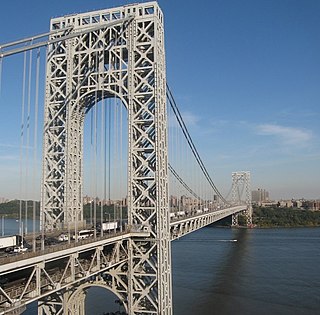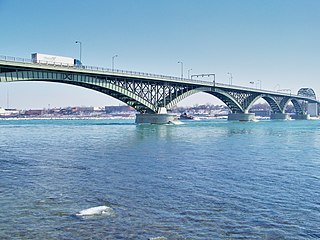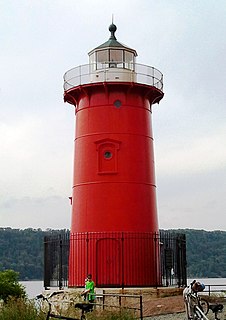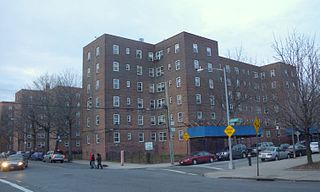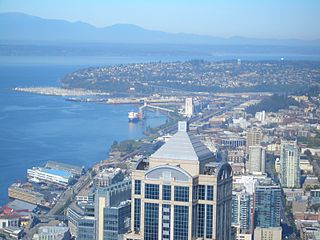| Fort Washington Park | |
|---|---|
Fort Washington Park view of the Little Red Lighthouse and George Washington Bridge | |
| Location | Along the Hudson River from W. 155 Street to Dyckman Street. |
| Coordinates | 40°50′58″N73°56′48″W / 40.84944°N 73.94667°W Coordinates: 40°50′58″N73°56′48″W / 40.84944°N 73.94667°W |
| Area | 160 acres (65 ha) |
| Operated by | NYC Parks |
| Website | http://www.nycgovparks.org/parks/fort-washington-park |
Fort Washington Park is located in the Washington Heights section of Upper Manhattan, New York City, along the banks of the Hudson River next to Riverside Drive from West 155th Street to Dyckman Street. The George Washington Bridge crosses above the park, and below the bridge is the small point of land also called Jeffrey's Hook, [1] which is the site of the Little Red Lighthouse.

Washington Heights is a neighborhood in the northern portion of the New York City borough of Manhattan. The area, with over 150,000 inhabitants as of 2010, is named for Fort Washington, a fortification constructed at the highest point on the island of Manhattan by Continental Army troops during the American Revolutionary War, to defend the area from the British forces. Washington Heights is bordered by Harlem to the south, along 155th Street, Inwood to the north along Dyckman Street or Hillside Avenue, the Hudson River to the west, and the Harlem River and Coogan's Bluff to the east.

Upper Manhattan denotes the most northern region of the New York City Borough of Manhattan. Its southern boundary has been variously defined, but 96th Street, the northern boundary of Central Park at 110th Street, 125th Street or 155th Street are some common usages.

Manhattan, often referred to locally as the City, is the most densely populated of the five boroughs of New York City and its economic and administrative center, cultural identifier, and historical birthplace. The borough is coextensive with New York County, one of the original counties of the U.S. state of New York. The borough consists mostly of Manhattan Island, bounded by the Hudson, East, and Harlem rivers; several small adjacent islands; and Marble Hill, a small neighborhood now on the U.S. mainland, physically connected to the Bronx and separated from the rest of Manhattan by the Harlem River. Manhattan Island is divided into three informally bounded components, each aligned with the borough's long axis: Lower, Midtown, and Upper Manhattan.
The 160-acre park features river-side views of the New Jersey Palisades and the George Washington Bridge. Amenities include pedestrian and greenway paths, baseball fields, basketball courts, tennis courts, volleyball courts, a soccer field and a playground.
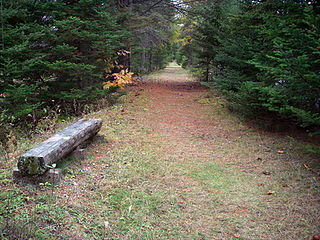
A greenway is "a strip of undeveloped land near an urban area, set aside for recreational use or environmental protection". However, the term can in fact include "a scenic road" and though many are in urban areas, there are some rural greenways, as for example the Monadnock-Sunapee Greenway, a hiking trail in southern New Hampshire.
The park references the nearby site of Fort Washington, a fortified position that was the site of the 1776 Battle of Fort Washington during the American Revolutionary War. The fort's actual location is located and commemorated in Bennett Park.

Fort Washington was a fortified position near the north end of Manhattan Island, at the island's highest point, within the modern-day neighborhood of Washington Heights, Manhattan, New York City. The Fort Washington Site is listed on the U.S. National Register of Historic Places.

The Battle of Fort Washington was a battle fought in New York on November 16, 1776 during the American Revolutionary War between the United States and Great Britain. It was a British victory that gained the surrender of the remnant of the garrison of Fort Washington near the north end of Manhattan Island. It was one of the worst Patriot defeats of the war.

The American Revolutionary War (1775–1783), also known as the American War of Independence, was an 18th-century war between Great Britain and its Thirteen Colonies which declared independence as the United States of America.

